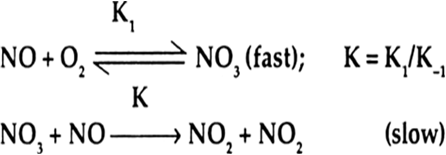 Short Answer Type
Short Answer Type Long Answer Type
Long Answer Type Short Answer Type
Short Answer Type Long Answer Type
Long Answer Type
The slow step is the rate determining step. In the slow step in this reaction, 1 molecule of NO3 (intermediate) and 1 molecule of NO combine to form the products. Therefore, rate of this reaction depends upon 1 concentration term of NO3 and 1 concentration term of NO.
∴ Molecularity of the reaction = 1 + 1 = 2.
Rate = K [NO3] [NO]
NO3 is an intermediate which is formed rapidly by the collision of 1 molecule of NO and 1 molecule of O2.
[NO3] ∝ [NO][O2]
Rate = K1 [NO3] [NO]
= K [NO] [O2] [NO]
= K [NO]2[O2]
Order of reaction is 2 + 1 = 3.
